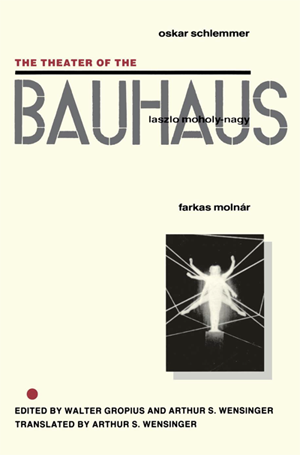BAUHAUSBUCH 04
OSKAR SCHLEMMER
DIE BÜHNE IM BAUHAUS
1925
schriftleitung
walter gropius
l. moholy-nagy
THE TRIADIC BALLET
The laws of cubical space are the invisible linear network of planimetric and stereometric relationships.
Source: University of Heidelberg
Originated 1912 in Stuttgart in cooperation with the dance team Albert Burger and Elsa Hötzel and the master craftsman Carl Schlemmer. First performance of parts of the ballet in 1915. First performance of the entire ballet September, 1922, in the Stuttgart Landestheater. Also performed in 1923 during the Bauhaus Week at the Nationaltheater, Weimar, and at the Annual Exhibition of German Crafts, Dresden.
The Triadic Ballet consists of three parts which form a structure of stylized dance scenes, developing from the humorous to the serious. The first is a gay burlesque with lemon yellow drop curtains. The second, ceremonious and solemn, is on a rose-colored stage. And the third is a mystical fantasy on a black stage. The twelve different dances in eighteen different costumes are danced alternately by three persons, two male and onefemale. The costumes are partly of padded cloth and partly of stiff papier-maché forms, coated with metallic or colored paint.
OSKAR SCHLEMMER
MAN AND ART FIGURE
The history of the theater is the history of the transfiguration of the human form. It is the history of man as the actor of physical and spiritual events, ranging from naivety to reflection, from naturalness to artifice. The materials involved in this transfiguration are form and color, the materials of the painter and sculptor. The arena for this transfiguration is found in the constructive fusion of space and building, the realm of the architect. Through the manipulation of these materials the role of the artist, the synthesizer of these elements, is determined.
One of the emblems of our time is abstraction. It functions, on the one hand, to disconnect components from an existing and persisting whole, either to lead them individually ad absurdum or to elevate them to their greatest potential. On the other hand, abstraction can result in generalization and summation, in the construction in bold outline of a new totality
A further emblem of our time is mechanization, the inexorable process which now lays claim to every sphere of life and art. Everything which can be mechanized is mechanized. The result: our recognition of that which can not be mechanized. And last, but not the least, among the emblems of our time are the new potentials of technology and invention which we can use to create altogether new hypotheses and which can thus engender, or at least give promise of, the boldest fantasies.
Stage (Buhne), taken in its general sense, is what we may call the entire realm lying between religious cult and naive popular entertainment. Neither of these things, however, is really the same thing as stage. Stage is representation abstracted from the natural and directing its effect at the human being. [...]
The question as to the origin of life and the cosmos, that is, whether in the
beginning there was Word, Deed, or Form - Spirit, Act, or Shape - Mind, Happening, or Manifestation - pertains also to the world of the stage, and leads us to a differentiation of: the oral or sound stage of a literary or musical event; the play stage of a physical-mimetic event; the visual stage of an optical event.
Poster for the bauhaus dancing,
Marcel Breuer Fiction of a stage for the inn "Ilmschlösschen 15"
Farkas Molnar U-THEATER
Kurt Schmidt, set design for the »Mechanische Ballett«
Bauhaus band with Hans Hoffmann, Heinrich Koch, Rudolph Paris, Andreas Weininger
oskar schlemmer
why this »triadisches ballett«?
because the number three is an eminently important dominant figure with which the monomane self along with the dualistic contrast have been overcome and the collective starts. it is closely followed by the five, the seven and so on. Taken from the trias triad the ballet could be called the dance of three analogues, the change between one, two and three. a danseuse and two dancers: twelve dances and eighteen costumes. Similar triforms are: form, colour, space; the three dimensions of space: height, depth, width; the basic forms: sphere, cube, pyramid, the basic colours: red, blue, yellow. the tri-unity of dance, costume, music.
Diary 5 July 1926
Source: exhibition catalog 50 years of Bauhaus Stuttgart 1968
Cover: Oskar Schlemmer
BAUHAUS BOOK 04
OSKAR SCHLEMMER
THE THEATER OF THE BAUHAUS
1925
ed: walter gropius
tr: arthur wensinger
wesleyan university press, 1961
Source: monoskop.org PDF 7 MB
bauhaus book 04
oskar schlemmer
the theater of the bauhaus
1925
ed: walter gropius
tr: arthur wensinger
wesleyan university press, 1961
3
